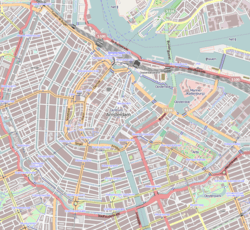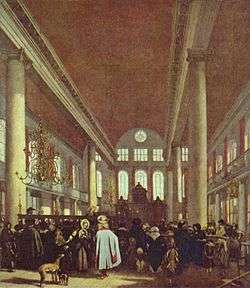Portuguese Synagogue (Amsterdam)
| Portuguese Synagogue | |
|---|---|
|
Exterior of the Portuguese Synagogue in 2015 | |
 Location in the city centre of Amsterdam | |
| Basic information | |
| Location | Amsterdam, Netherlands |
| Geographic coordinates | 52°22′03″N 4°54′19″E / 52.3675°N 4.9054°ECoordinates: 52°22′03″N 4°54′19″E / 52.3675°N 4.9054°E |
| Affiliation | Orthodox Judaism |
| Rite | Sephardi |
| Status | Active |
| Website |
portugesegemeente |
| Architectural description | |
| Architect(s) | Elias Bouwman |
| Architectural type | Synagogue |
| Groundbreaking | April 17, 1671 |
| Completed | August 2, 1675 |

The Portuguese Synagogue, also known as the Esnoga (Ladino: אסנוגה), or Snoge, is a late 17th-century Sephardic synagogue in Amsterdam, completed in 1675. Esnoga is the Ladino word for synagogue.
The Amsterdam Sephardic community was one of the largest and richest Jewish communities in Europe during the Dutch Golden Age, and their very large synagogue reflected this. The synagogue is a popular tourist attraction.
Background

The Sephardim (Hebrew for "Jews of Spain") were issued with the Spanish Royal Alhambra Decree in 1492, whereby they were given the choice of exile from Spain, or conversion to Catholicism, or failing to do either, execution. Of Spain's estimated 200,000 Jews at that time, around half converted; many by coercion, others because of social and financial pressures preventing their departure, and a few out of genuine religious conviction. They became Spain's Jewish-origin New Christians or conversos (i.e. "converts" to Catholicism).
Of the other half of Spain's Jews who did not convert, and instead chose exile, some sailed south (becoming the North African Sephardim), others went east (becoming the Eastern Sephardim), but most crossed the border west to Portugal.
In Portugal, Jewish life was interrupted only a few years later, when there too they were issued with the Portuguese decree against the Jews in 1496. While in theory, the Jews now in Portugal who chose not convert to Catholicism also had the option to be expelled (or executed) by 1497, the Portuguese king, not wanting a similar Jewish flight and brain drain as happened in Spain, in practice blocked Portugal's ports of exit, and subsequently reasoned that those who stayed behind agreed to become Christians by default. Thus the Jews in Portugal were forced to convert to Catholicism in 1496 after the decree and, all but a few who did manage to flee, became Portugal's Jewish-origin New Christians or conversos.
For the next few centuries, the Inquisition in Spain and Portugal continued to investigate the conversos and their descendants on suspicions that they continued to practice Judaism in secret. Many in fact did continue to practice Judaism behind closed doors, while publicly professing to be Catholics; in Spanish and Portuguese these were called Marranos.
The persecutions and trials by the inquisition against conversos lasted well into the late 1800s. Furthermore, the legal distinction between so-called Old Christians and New Christians was maintained for centuries, with a person's pedigree always on record.
Both those who actively maintained Jewish practices in secret, and also some sincere conversos who had converted fully to Catholicism, were at times hounded, persecuted and executed from charges of being Marranos. This was often a pretext for the confiscation of their property. Many of them wished to have freedom of religion again and to be free from this institutionalized anti-Semitism. Amsterdam, then one of the greatest cities in the world, offered both of these things.
In this historical context, a substantial migration of conversos from the Iberian Peninsula to Amsterdam took place from the 1600s to the early 1800s. Once in Amsterdam, many returned to Judaism openly and publicly. They called themselves Portuguese Jews, even those who came directly from Spain. They wanted to avoid being identified with Spain, which was at war with the Dutch Republic at the time during the Eighty Years' War. This branch of Judaism is also known as the Western Sephardim.
Construction and building
On December 12, 1670, the Sephardic Jewish community of Amsterdam acquired the site to build a synagogue and construction work began on April 17, 1671, under the architect Elias Bouwman. On August 2, 1675, the Esnoga was finished.
The inscription above the entrance is from Psalm 5:8: "In the abundance of Thy lovingkindness will I come into Thy house". The sign also contains "1672", the year the building was intended to be completed, and "Aboab", the name of the chief rabbi who initiated the construction project.
The building is free-standing and rests on wooden poles; the foundation vaults can be viewed by boat from the canal water underneath the synagogue. The entrance to the main synagogue is off a small courtyard enclosed by low buildings housing the winter synagogue, offices and archives, homes of various officials, the rabbinate, a mortuary, and noted Etz Hayim library. The interior of the synagogue is a single, very high rectangular space retaining its original wooden benches. The floor is covered with fine sand, in the old Dutch tradition, to absorb dust, moisture and dirt from shoes and to muffle the noise. Only five synagogues in the world have a sand floor, and this is the only one with such a floor surviving outside the Caribbean region.
During the 1955–1959 renovation, the former Etz Hayim seminary auditorium was redesigned as a winter synagogue; central heating and electric lighting were added. The benches were taken from a synagogue originally built in 1639 and the Hechal dates from 1744.
Baruch Spinoza was expelled from this synagogue community for his writings.
Ets Haim Library
The Portuguese Synagogue has one of the oldest Jewish libraries in the world and filled with original and rare texts. It is called upon for academic and rabbinical research all the time. It was founded in 1639 and has been housed in the historical complex of the Portuguese Jewish community of Amsterdam since 1675. In 1889 the private library of the then librarian David Montezinos was donated to Ets Haim and the library is known since then as Ets Haim/Livraria Montezinos. [1]
Image gallery
-
.jpg)
General view with the synagogue at left, 18th century
-

Exterior, side view
-

The exterior of the Esnoga
-

Interior, lit up with candles
-

Looking Up
-

Windows with Natural Light
-

Foundation memorial stone
-

Ark or Hekhál
-

Hekhál from upstairs
-

Chapel in the compound
-

Memorial Plaques in the Chapel
-

Memorial Chapel
-

Silver Torah Decorations
-

Cloth Torah Cover
-

Books from the Etz Chaim Library on display
-

Detail of Torah Breast Plate
-

Detail of Cloth From Torah Decorations
-

Room for Mourning where the body is watched over until burial
-

Jewish Mourning Room
-

Rabbinical Customer for official services
-

Sophorim from Etz Chaim
-

Sophorim from Etz Chaim
-

Sohporim from Etz Chaim
-

A close-up of Hezekiah da Silva, as portrayed in a drawing found in the Rabbis' room
Canon of Amsterdam
- the High German and Portuguese Synagogue is window number 19 in the Canon of Amsterdam.
See also
- History of the Jews in the Netherlands
- Sephardic Jews in the Netherlands
- Spanish and Portuguese Jews
- Joods Historisch Museum, a Jewish historical museum occupying four former synagogues adjacent to the Esnoga
- Jekuthiel Sofer, an 18th-century scribe at the Esnoga.
- Curaçao synagogue
- Tzedek ve-Shalom, Sephardic synagogue in Suriname built by a community that flew the Inquisition
References
External links
| Wikimedia Commons has media related to Portugees-Israëlietische Synagoge. |
- Website of the Esnoga
- Archive of the Portuguese-Israelite community in Amsterdam, in the Archives Database of the Amsterdam City Archives
- Consecration of the new Portuguese synagogue August 2, 1675. Bibliotheca Rosenthaliana
- Website of Ets Haim, Sephardi library
- UNESCO listing in the World memory
- Robert Cohen (1987). ""Memoria Para Os Siglos Futuros": Myth and Memory on the Beginnings of the Amsterdam Sephardi Community". Jewish History. 2. JSTOR 20101033.
